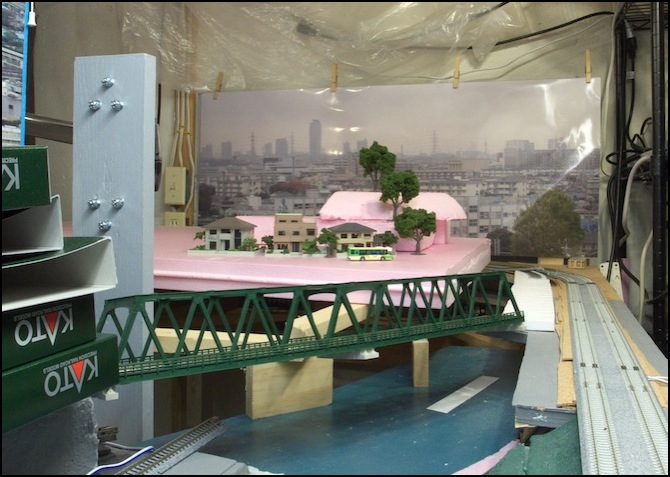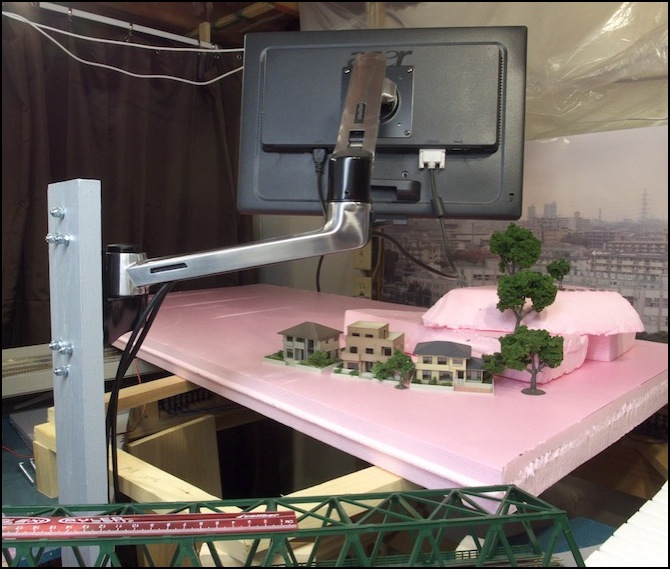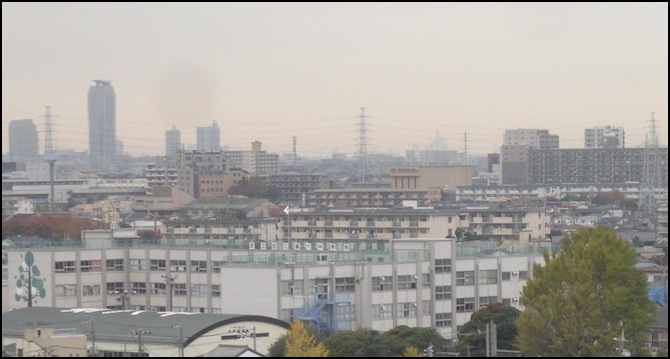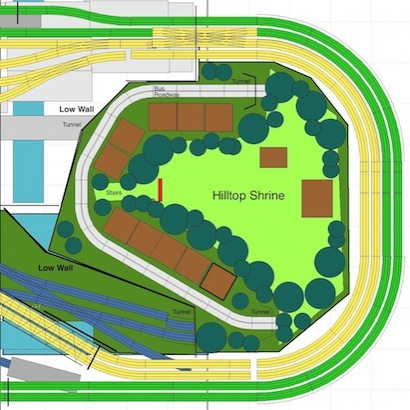Hilltop Scene
The portion of the layout long-known as the “unsceniced” end is finally getting some scenery. This wasn’t the original plan. What I had planned was to hide this utilitarian section behind some backdrops, so the fact that the tracks curved around to return wouldn’t be obvious. Now I’ve decided that I can do the same thing with a low hill, and this will give me a place for additional houses and other low structures characteristic of the outer regions of Tōkyō, which have a more residential / light-commercial feel to them. It will also allow a spot of nature to be added, typical of the small inclusions of natural landscape within the bounds of the city.
At present, the Hilltop scene exists mostly in my imagination, which is still working out the details. Construction of the backdrop is under way (and has been for a month; I’m not very fast) and I’m still trying to work out fundamentals like how high the “ground” around the hill will be, how high the hill will rise above it, and how I’m going to support the scenery above the future helix without blocking trains using it.
But after six months of pondering those questions, the answers are firming up. To try out my current ideas, I build a mockup of the future hilltop using some scraps of pink insulation foam and a sheet of it I had left over from the original construction. In the photo below, the raw wood under the foam is my current best guess at a support structure. I’m confident enough that I’ve cut the wood to length, but doubtful enough that I haven’t glued or screwed any of it in place yet.
In the mockup, the base level is 2” foam (2.5 cm) sheet, held atop the wood. This places the upper surface 6” (~15 cm) above the river level, a scale 75’ (23 m). That’s really too high for an urban river canyon. Some of them are quite high-walled, to deal with typhoon-season drainage they channel, but this is about three time too high. It does, however, have the advantage of hiding the ground-level tracks on the far side. My earlier thought had been to try to put the houses at track level, but I’ve moved away from that. I suspect I’ll live with the “too high” part. There are certainly a few places around Tōkyō with that kind of elevation change: the hill southwest of Tabata yard on the north side of the city, for example, is about 70’ above the tracks in the yard.
The “hill” itself is currently looking to be two layers of foam (4” or 10 cm) above this. That’s a reasonable height, about 50’ (15 m). There are plenty of low hills of that height in residential districts around the city. And as you can see in the mockup photo below, this makes the hill visible above the foreground bridge, but allows the scenic backdrop to rise above it.

Mockup of the Hilltop
This is also about as high as I can make the hilltop, as I have to watch the overhead clearance. The monitor that will eventually display the JMRI track panel, showing location of trains and state of switches, is on a swivel arm so it can be viewed from either side of the layout. It needs to pass over the hilltop scene, and as you can see below, it just clears the tree level in the mockup.

Monitor clearance test
As you can see above, there will be a backdrop against the wall, with the hilltop rising in front of it. The four tracks of the Express and Commuter loops wrap around behind the hilltop, exposed but mostly hidden from view, disguising the fact that they’re looping around without needing to hide them in a tunnel (the subway tracks will also loop, but they’re already hidden on the level below the other tracks).
The backdrop photo is cut down from a picture of suburban Tōkyō, apparently taken from a train (there’s what looks like a spot of rain on the window in the sky, center-left). This shows a foregronund school building, and a hazy distant city-scape. Normally I’d not use a photo this low-resolution for a backdrop, and I’d avoid one having these kinds of flaws (haze, “through glass” distortion). But since the nearest viewing point will be over four feet (120 cm) away, and most viewing will be from 6-9 feet (2-3 m) distance, and the idea is just to suggest “something more” behind the hilltop, I think this will work. If not, I can always glue another photo over it.

Photographer: jam_232
Construction of the backdrop is in progress. I’ve printed the full-size image and built and painted the hardboard structure for it, per my usual technique for Constructing Backdrops, and now I just need to glue the one to the other and bolt the result to the layout table frame (I use bolts so I can disassemble the backdrop from the layout for either replacement/repair, or when moving). I haven’t glued the photo on yet, in part because I’m still working on the mounting for the backdrop. Camping it to the frame is proving troublesome because of the way I build that. In the mock-up photo above, it’s held to the backdrop with some clothespins. But I finally worked out the supports, and those are under construction. I should be able to glue the photo on and clamp the backdrop in place soon.
Scenery
I’ve been giving the scenery more thought, and had an interesting idea: I can incorporate a loop of the Moving Bus System roadway (or make my own roadway for them) into the hill, and just hide the back portion under the raised central level I’d already been planning. This only allows for vehicles moving in one direction, and today the only vehicle possible is the bus (or something built on a similar long-wheelbase frame, like an industrial tow-truck). But it will add a bit more “background activity” to the layout, and that’s worth doing.
In addition to the road with houses, the other thing that I really want to incorporate is a Shinto shrine on the hilltop. Models for these are scarce (Buddhist temples are more common models). Tomytec made one back in 2008 (Building Collection 10, Shinto Shrine), but it’s been sold out for some time and these “collection” buildings aren’t generally re-run (they’re seen as collectibles). But last fall, they re-issued it as “Building Collection 10-2 Vermillion Wrapped Shinto Shrine” (the difference seems to be red paint on the buildings, which likely implies an association of the shrine with Inari, the fox god). And while the all-in-one set was sold out, the basic set was not. This doesn’t include people, trees, or vendor stalls (and may be missing a couple of smaller outbuildings too; I can’t quite puzzle out the contents list). But most of that I can get separately. So an order has been placed to give me something to put atop the hilltop.
While both shrines and temples are very common, the shrines seem more specifically Japanese to me. Shinto is the original religion of Japan, and while it coexists with Buddhism (and has for centuries) and with a small amount of Christianity (introduced by the Portuguese in colonial times and with a small following, but today more often encountered in its commercial Christmas symbolism), Shinto is very specifically a characteristic of Japan, from small roadside shrines a couple of feet across, to larger sites that cater to festival crowds. It’s one of the latter I’ll model, although probably not at festival time. I’ve seen that done on too many layouts to want to “me too” it.
The diagram below is my current planning diagram. The dark green inside the outline is the portion raised to the same level as the yellow/green tracks. The dark green on the lower left is at the lower river/subway level, about 3” (7.5 cm) lower), as is the white portion and the road/river on it. The light green will be raised up enough to contain the bus system, perhaps 2-3” (5 - 7.5 cm) higher than the dark green track-level portion. I might go higher if I think it’s going to make for a more realistic hill, but I’m aiming for the kind of low elevation seen on the Kanto plain, where small hills not much higher than a house or two atop each other are commonplace but larger ones are not.
One reference I’m using is a small hill and shrine in northwestern Tokyo (Google Maps), the Akabane Hachiman shrine. Hachiman is the god of both archery and war, general protection and of farming and agriculture, and his are the second-most common kind of shrine in Japan. Shrines dedicated to Inari Ōkami, the god of “of foxes, of fertility, rice, tea and Sake, of agriculture and industry, of general prosperity and worldly success” (per wikipedia) are the most common. I’ll probably end up modeling an Inari shrine, as the model I ordered appears to be of one (red is a color associated with the fox god). But the Akabane shrine gives me a model for an “urban shrine on a low hill near a railway”, which should help guide my modeling (and there are a lot of photos of it in Google since it’s next to a railway station and likely gets a lot of traffic as a result).

What it will look like (wall end at right)




